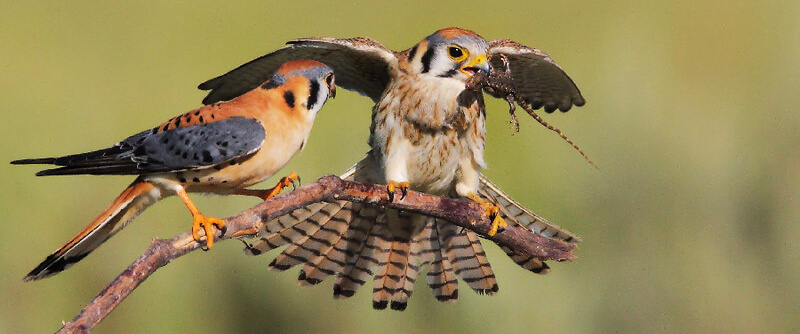New Study Says Stress from Human Activity Can Cause Urban Birds to Abandon Nests Ten Times More Often

Kestrels may be abandoning nests far more in urban environments than in more distant locations. American Kestrels by Steve Wolfe. Photo may be used with credit in connection with this story.
(Washington, D.C., May 13, 2013) A new study from scientists at Boise State University shows that even bird species considered “tolerant” of human activity, such as American Kestrels, may be adversely impacted by human disturbance to a far greater degree than many had believed.
The study, authored by Erin H. Strasser and Julie A. Heath of Boise State University, was just published in the British Ecological Society's Journal of Applied Ecology.
A key finding of the study was that American Kestrels nesting in close proximity to roads and developed areas had elevated stress hormones and high rates of nest abandonment – about ten times higher than kestrels in less-developed areas. American Kestrels are small, colorful falcons often seen perched along roadways and are abundant in urban and agricultural areas.
“In the case of the kestrel, the bird is possibly drawn into the urban environment by the abundant nesting and perching opportunities that environment provides and by the improved prey visibility provided by shorter grass. Unfortunately, this dynamic creates an ecological trap as ultimately the stresses caused by human activity lead the bird to abandon nests far more frequently,” said Heath.
The study involved the monitoring of 89 nest boxes along Idaho's Interstate 84 (28 nests) as well as on posts and trees along secondary roads in other areas such as suburban (10 nests), rural-residential (24 nests), agricultural (22 nests) and shrubland (15 nests) in the breeding seasons of 2008 and 2009. Most (23 nests, 88%) of the nests that failed did so during incubation. Only three nests failed during the nestling stage. Sixteen of the 26 failed nests (62%) were abandoned.
The study says that cavity nesting birds, such as kestrels, who inhabit noisy environments may compensate for decreased auditory cues by increasing vigilance behaviour, such as visual scans from the nest entrance or flushing from the nest, leading to changes in energy allocation or extended periods away from the nest during incubation. This behavior appears to be followed, at a high rate, by nest abandonment.
The researchers looked at corticosterone levels, which indicate degrees of stress – the equivalent of cortisol in humans. Corticosterone can lead to behavioral and physiological changes that enable individuals to cope with stressful situations, while suppressing other activities such as reproduction.
The data showed that female kestrels nesting in areas with high human activity, such as along noisy roadways, have higher corticosterone levels, but males do not. This could be because females spend more time in the nesting box and thus are exposed more often to stressors such as vehicle noise. These effects lessened the further a nest was from the road.
“Birds evolved in an environment that was not dominated by humans,” Heath noted. “In recent history, human roads and structures have left few areas untouched. We're just starting to understand the real consequences.”
Given that the vast majority of land in the continental United States is within a mile of a road, wildlife increasingly are exposed to chronic levels of road noise. The resulting increase in stress levels could cause fundamental changes in physiology and behavior across species inhabiting human-dominated environments, which over time could lead to population declines.
As scientists continue to connect the dots between human disturbances and the resulting long-term effects on wildlife, changes already are yielding positive results. Research conducted in preserve areas, such as state parks, has led to reduced speeds and attempts to limit noise, although noise mitigation, while locally effective, may not protect widespread populations such as kestrels from the pervasive threat of traffic noise.
The study concludes that until regulations or economic incentives are developed to encourage engineering innovations that result in quieter roads, projects in areas of human activity with favorable habitat should be discouraged in order to decrease the risk of ecological traps.
According to Dr. George Fenwick, President of American Bird Conservancy, one of the leading U.S. bird conservation organizations, “Many people think that since they see certain species of birds in urban environments, that they must have adapted to those unnatural surroundings. This study certainly suggests that at least in some circumstances, the exact opposite is true. Birds are being lured away from their more natural environment, into areas where their ability to reproduce is clearly being compromised.”


















































